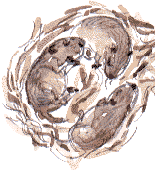
|
Bank VoleSunday, 3rd August 2003, West Yorkshire |
![]()
![]()
![]()
![]() Rocks | History |
Workshop |
Links | Home
Page
Rocks | History |
Workshop |
Links | Home
Page
![]()

We're surprised to the see a bank vole
so active, running around the patio by the tub under the bird table in
the bright morning sunlight at breakfast-time:  a
quick whiz by is usually all we see.
a
quick whiz by is usually all we see.
Mice and voles can be a bit confusing, so here's a list of the characteristics of the bank vole:
![]() Next page | Previous page |
This day two years
ago | This month |
Nature Diary |
Home
Page
Next page | Previous page |
This day two years
ago | This month |
Nature Diary |
Home
Page
![]()



